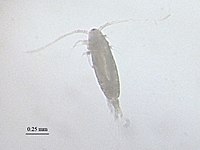
Assessment of swimming behavior of the Pacific oyster D-larvae (Crassostrea gigas) following exposure to model pollutants
Sign Up to like & getrecommendations! Published in 2019 at "Environmental Science and Pollution Research"
DOI: 10.1007/s11356-019-04156-8
Abstract: This study describes an image analysis method that has been used to analyze the swimming behavior of native oyster D-larvae (Crassostrea gigas) from the Arcachon Bay (SW, France). In a second time, this study evaluated… read more here.
Keywords: oyster larvae; larvae crassostrea; swimming behavior; crassostrea gigas ... See more keywords

Copepod swimming behavior, respiration, and expression of stress-related genes in response to high stocking densities
Sign Up to like & getrecommendations! Published in 2017 at "Aquaculture Reports"
DOI: 10.1016/j.aqrep.2017.03.001
Abstract: Abstract Using copepod nauplii as live feed in aquaculture hatcheries could solve high mortality rates of first-feeding fish larvae due to malnutrition. However, implementing the use of copepod nauplii on an intensive production scale requires… read more here.
Keywords: response; behavior respiration; swimming behavior; stress ... See more keywords

Karenia brevis causes high mortality and impaired swimming behavior of Florida stone crab larvae.
Sign Up to like & getrecommendations! Published in 2019 at "Harmful algae"
DOI: 10.1016/j.hal.2019.04.007
Abstract: The dinoflagellate Karenia brevis causes harmful algal blooms commonly referred to as red tides that are prevalent along Florida's gulf coast. Severe blooms often cause fish kills, turbid water, and hypoxic events all of which… read more here.
Keywords: stone; swimming behavior; brevis; larvae ... See more keywords

Characterization of Sulfoxaflor and Its Metabolites on Survival, Growth, Reproduction, Biochemical Markers, and Transcription of Genes of Daphnia magna.
Sign Up to like & getrecommendations! Published in 2023 at "Journal of agricultural and food chemistry"
DOI: 10.1021/acs.jafc.2c08748
Abstract: Sulfoxaflor is a promising neonicotinoid. However, the negative implications of sulfoxaflor on nontarget aquatic organisms have been rarely studied. In this study, the risks of sulfoxaflor and its main metabolites X11719474 and X11519540 on Daphnia… read more here.
Keywords: swimming behavior; sulfoxaflor; x11719474 x11519540; daphnia magna ... See more keywords

Leachate effects of pelagic Sargassum spp. on larval swimming behavior of the coral Acropora palmata
Sign Up to like & getrecommendations! Published in 2020 at "Scientific Reports"
DOI: 10.1038/s41598-020-60864-z
Abstract: An emerging disturbance for Caribbean reefs is the massive arrival of pelagic Sargassum, which deteriorates water quality due to the production of leachates. The highest arrivals of Sargassum took place when broadcasting corals spawned. We… read more here.
Keywords: swimming behavior; larval swimming; pelagic sargassum; sargassum ... See more keywords

Reversible single cell trapping of Paramecium caudatum to correlate swimming behavior and membrane state.
Sign Up to like & getrecommendations! Published in 2022 at "Biomicrofluidics"
DOI: 10.1063/5.0084084
Abstract: Single cell measurements with living specimen like, for example, the ciliated protozoan Paramecium caudatum can be a challenging task. We present here a microfluidic trapping mechanism for measurements with these micro-organisms that can be used,… read more here.
Keywords: cell; swimming behavior; paramecium caudatum; single cell ... See more keywords

The effects of suspended sediments on the swimming behavior of the calanoid copepod, Acartia tonsa
Sign Up to like & getrecommendations! Published in 2020 at "Journal of Plankton Research"
DOI: 10.1093/plankt/fbz071
Abstract: Copepod swimming behavior is governed by chemical and hydro-mechanical cues. The environment of copepods, however, is frequently impacted by anthropogenic activities, in particular increased levels of suspended sediment due to coastal development. To better understand… read more here.
Keywords: copepod; acartia tonsa; swimming behavior; effects suspended ... See more keywords

Swimming behavior of emigrating Chinook Salmon smolts
Sign Up to like & getrecommendations! Published in 2022 at "PLoS ONE"
DOI: 10.1371/journal.pone.0263972
Abstract: Swimming behavior of Chinook Salmon (Oncorhynchus tshawytscha) smolts affects transit time, route selection and survival in complex aquatic ecosystems. Behavior quantified at the river reach and junction scale is of particular importance for route selection… read more here.
Keywords: behavior emigrating; salmon smolts; swimming behavior; chinook salmon ... See more keywords

Swimming behavior and hydrodynamics of the Chinese cavefish Sinocyclocheilus rhinocerous and a possible role of its head horn structure
Sign Up to like & getrecommendations! Published in 2022 at "PLoS ONE"
DOI: 10.1371/journal.pone.0270967
Abstract: The blind troglobite cavefish Sinocyclocheilus rhinocerous lives in oligotrophic, phreatic subterranean waters and possesses a unique cranial morphology including a pronounced supra-occipital horn. We used a combined approach of laboratory observations and Computational Fluid Dynamics… read more here.
Keywords: sinocyclocheilus rhinocerous; hydrodynamics; swimming behavior; lateral line ... See more keywords

The effects of exploratory behavior on physical activity in a common animal model of human disease, zebrafish (Danio rerio)
Sign Up to like & getrecommendations! Published in 2022 at "Frontiers in Behavioral Neuroscience"
DOI: 10.3389/fnbeh.2022.1020837
Abstract: Zebrafish (Danio rerio) are widely accepted as a multidisciplinary vertebrate model for neurobehavioral and clinical studies, and more recently have become established as a model for exercise physiology and behavior. Individual differences in activity level… read more here.
Keywords: swimming behavior; tank; tank diving; exploration ... See more keywords

Swimming Behavior of Daphnia magna Is Altered by Pesticides of Concern, as Components of Agricultural Surface Water and in Acute Exposures
Sign Up to like & getrecommendations! Published in 2023 at "Biology"
DOI: 10.3390/biology12030425
Abstract: Simple Summary New types of pesticides are increasingly found in surface waters around the world. Little is known about how they interact in mixtures, and how these mixtures might then affect aquatic organisms at risk… read more here.
Keywords: pesticides concern; chl imi; surface waters; swimming behavior ... See more keywords